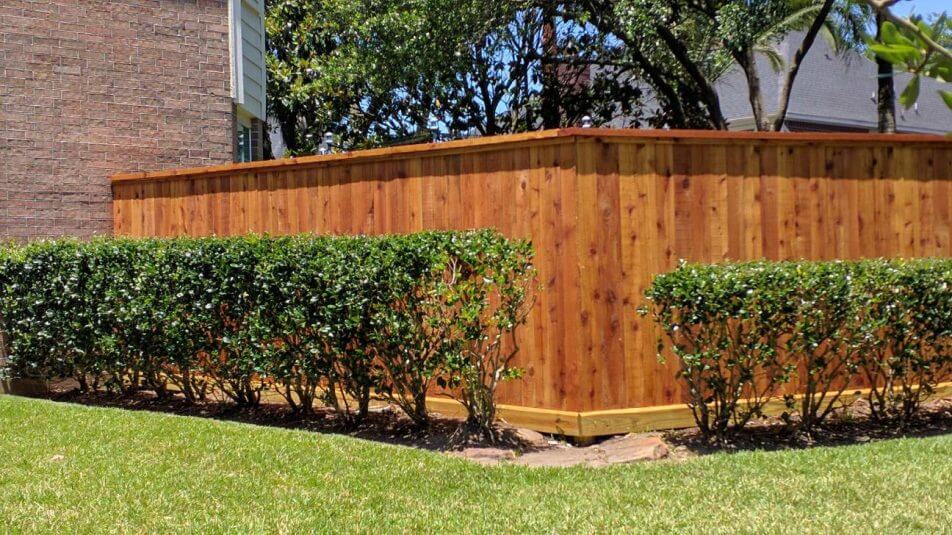Privacy Fence: Designs, Materials, and Installations for Backyards
Privacy is priceless, and a well-constructed fence can deliver this very necessity right into your Houston backyard. Want to spice up your outdoor space while adding an extra layer of isolation from prying eyes? Join us as we delve into the world of privacy fences. We’ll walk you through diverse designs, material choices, and even provide a step-by-step installation guide to help you bring an incredible blend of style and solitude to your backyard retreat.
A privacy fence is a type of fencing that creates a barrier between your property and the outside world, providing seclusion and security. There are many options for privacy fences, including wood, vinyl, chain-link with slats, aluminum, and more. Each material has its advantages and disadvantages in terms of cost, durability, appearance, and maintenance requirements. In addition to selecting the right material for your needs, it’s important to consider local zoning regulations and specific installation techniques to ensure you build your fence safely and effectively.

Types of Privacy Fences
Privacy fences serve an essential purpose in providing seclusion and security for your backyard. There are several types of privacy fences available, each with its own unique design, materials, and installation methods. Let’s explore some popular options:
Picket Fences
Picket fences have long been associated with the traditional concept of the American dream home. These charming and iconic fences consist of evenly spaced vertical boards, called pickets, that are attached to horizontal rails. Picket fences are usually made from wood but can also be constructed using materials like vinyl or aluminum for a lower maintenance option.
Picket fences not only provide privacy but also add aesthetic appeal to your backyard. They come in various heights and styles, including dog-ear, Gothic, and French Gothic designs. Dog-ear picket fences have flat tops with diagonal cuts on each end of the pickets, while Gothic styles feature pointed or rounded tops for a more decorative look.
One of the main advantages of picket fences is their ability to maintain privacy without totally isolating the property from the outside world. The spaces between the pickets allow for airflow and visibility while still creating a sense of enclosure. This makes picket fences an ideal choice for those who want both privacy and a welcoming feel.
It’s important to note that wooden picket fences require regular maintenance, including painting or staining to protect them from weathering. Vinyl or aluminum picket fences offer a low-maintenance alternative while still achieving the classic look.
For example, if you have a small backyard garden and want to create a boundary without compromising the visibility of your beautiful blooms, a picket fence could be an excellent choice. Its open design allows you to showcase your flowers while defining the space and enhancing curb appeal.
Wooden Fences
Wooden fences are a popular choice for privacy fencing due to their classic look and natural appeal. They provide an excellent balance of functionality, aesthetics, and affordability. One of the key advantages of wooden fences is their versatility in design. Whether you prefer a traditional picket style or a more modern horizontal plank arrangement, wood can be customized to suit your backyard’s unique aesthetic. Moreover, wood is a renewable resource, making it an environmentally friendly option.
When it comes to materials, cedar and redwood are often preferred for their durability and resistance to rot and insect damage. These types of wood also possess natural oils that naturally protect against decay, reducing the need for frequent maintenance and staining. However, other less expensive options like pine or spruce can still be used if properly treated and maintained.
Let’s imagine you have a picturesque backyard with a rustic feel, surrounded by lush greenery. A wooden fence made from cedar could enhance the overall charm, blending seamlessly into the natural surroundings while providing privacy from prying eyes.
In terms of installation, wooden fences require sturdy posts to ensure stability and longevity. Proper post placement is crucial to prevent sagging or leaning over time. It is recommended to dig post holes at least one-third the height of the fence panel and secure them with concrete for optimal support.
Maintaining a wooden fence involves regular inspections for any signs of damage or wear, such as loose boards or rot. It is advisable to clean the fence periodically using mild soap and water to remove dirt and debris. Staining or painting every few years helps preserve the wood’s appearance and protects it against weathering elements.
However, it’s important to note that wooden fences do have some drawbacks as well. Wood requires ongoing maintenance compared to other materials such as vinyl or metal fences. Exposure to the elements can cause wood to warp, fade, or become damaged over time, requiring repairs or replacements. Additionally, wood is more susceptible to pests like termites, which can pose long-term issues if not addressed promptly.
Solid Fences
Solid fences offer maximum privacy and security due to their complete blockage of views from both sides. They are commonly constructed using materials such as vinyl, composite, metal, brick, or stone. Solid fences provide an effective barrier against noise pollution, making them ideal for homeowners living near busy roads or noisy neighbors.
Vinyl fences are a popular choice for solid fences due to their low maintenance and durability. They are available in a variety of colors and styles, allowing homeowners to find a design that complements their outdoor space. With minimal upkeep required, vinyl fences are resistant to rotting, fading, and warping, making them a long-lasting option.
Imagine you have a beautifully landscaped backyard oasis where you can relax and unwind without any disturbances. A solid vinyl fence would be the perfect solution to create an intimate and tranquil atmosphere while keeping unwanted views out.
Another sturdy material used for solid fences is brick or stone. These options add an elegant and timeless touch to any property while providing unmatched durability and strength. However, it’s worth noting that these types of solid fences require professional installation due to their weight and structural considerations.
| Materials | Benefits |
| Vinyl | Low maintenance and durability |
| Brick/Stone | Elegant appearance and exceptional strength |
| Metal | High-security features and longevity |
Some homeowners may argue that while solid fences provide excellent privacy, they limit visibility from within as well. This can create a closed-off feeling in the backyard and reduce the ability to enjoy surrounding views or maintain visual contact with children or pets. It’s important to consider personal preferences and the specific needs of your property when deciding on the right type of fence.
Having explored the benefits and considerations of wooden fences and solid fences, let’s now delve into a discussion about the overall advantages and drawbacks of privacy fences.
Benefits and Drawbacks of Privacy Fences
Privacy fences are a popular choice for homeowners looking to create a secluded and secure outdoor space. However, like any home improvement project, there are both benefits and drawbacks to consider before installing a privacy fence.
Enhanced Security Benefits
One of the significant advantages of privacy fences is the enhanced security they provide. By enclosing your backyard with a solid barrier, you can significantly reduce the risk of unwanted intrusions and trespassing. These fences act as a deterrent, preventing potential thieves or individuals from accessing your property easily.
Furthermore, privacy fences can help safeguard your children and pets by creating a barrier between them and external hazards such as busy streets or neighboring animals. This added layer of protection gives parents peace of mind knowing that their loved ones can play freely within the confines of their backyard without compromising safety.
In addition to physical security, privacy fences also offer psychological security by creating a sense of seclusion and peace. They shield your outdoor living space from prying eyes, allowing you to relax and enjoy your backyard without feeling exposed to neighbors or passersby. This increased privacy fosters a comfortable and intimate atmosphere where you can host gatherings or simply unwind in solitude.
Imagine sitting on your patio, sipping a cup of coffee, or reading a book, completely undisturbed by the world outside thanks to the seclusion provided by your privacy fence. It creates an oasis within your own property where you can fully embrace tranquility.
However, it’s important to acknowledge that while privacy fences offer numerous benefits, they do come with some considerations.
Potential Drawbacks to Consider
While privacy fences offer numerous benefits, it’s essential to consider potential drawbacks before deciding on installation. One significant consideration is the cost involved. Privacy fences often require more materials and labor compared to other types of fences, resulting in a higher price tag. However, it’s crucial to weigh this against the increased privacy and security it offers.
Another aspect to keep in mind is maintenance. Depending on the material chosen for the fence, regular upkeep may be necessary. Wood fences, for example, require staining or sealing every few years to protect against weathering and prolong their lifespan. Vinyl or aluminum fences, on the other hand, generally require less maintenance but may still benefit from occasional cleaning.
Additionally, installing a privacy fence might have implications for the aesthetics of your property. While these fences provide excellent screening and security, they can appear imposing or dominant in certain settings. It’s important to consider how the fence will complement your existing landscape and architectural style.
Furthermore, local regulations and homeowners’ association guidelines might dictate specific height restrictions or design limitations for privacy fences. Ensuring compliance with these rules is crucial to avoid potential conflicts and costly modifications later on.
Finally, it’s worth considering the impact on natural lighting and airflow within your yard. A tall and solid privacy fence can block sunlight, casting shadows that may affect plants or seating areas. It can also reduce air circulation, potentially leading to moisture buildup in certain areas of your yard.
By carefully weighing these potential drawbacks against the benefits you seek from a privacy fence, you can make an informed decision that aligns with your needs and preferences.
Essential Guide to Installing a Privacy Fence
Installing a privacy fence requires careful planning and attention to detail. By following this essential guide, you’ll be better prepared for a successful installation process.
- Check Local Regulations: Ensure you are familiar with any permits or restrictions required by local authorities or homeowners’ associations before starting the project. This step will prevent any inconvenience or potential penalties down the line.
- Choose the Right Materials: Select a durable and low-maintenance material that suits your preferences and budget. Common options include wood, vinyl, aluminum, and composite materials. Consider factors such as aesthetics, durability, resistance to weather, and privacy levels when making your choice.
- Determine the Layout and Measurements: Carefully plan the layout of your fence, marking the boundaries and taking accurate measurements. Ensure that you account for any slopes or uneven terrain in your yard.
- Prepare the Site: Clear the area of any obstacles such as vegetation or debris. Use a string line or stakes to mark the fence’s perimeter accurately. Dig post holes at regular intervals based on your measurements, ensuring proper depth and spacing.
- Install Fence Posts: Set the fence posts securely in concrete or gravel, making sure they are level and plumb. Allow adequate time for the posts to cure before proceeding with the next steps.
- Attach Fence Panels: Once the posts are set, attach your chosen fence panels securely to them using appropriate hardware such as screws or brackets. Ensure that each panel is level and properly aligned with adjacent panels.
- Add Finishing Touches: Depending on your design preferences, consider adding features such as gates, decorative elements, or post caps to enhance the appearance of your privacy fence.
- Perform Regular Maintenance: Follow manufacturer guidelines for maintenance to ensure the longevity of your fence. This may include periodic cleaning, staining or painting (if applicable), and inspections for repairs or adjustments.
By following these essential steps, you can achieve a well-installed privacy fence that provides both functionality and aesthetic appeal to your backyard.
DIY Installation Process
If you’re a handy homeowner looking to save some money and take on a rewarding project, you might consider tackling the installation of your privacy fence on your own. The DIY installation process can be an enriching experience, allowing you to have full control over the design and construction of your backyard oasis. But before you pick up a hammer and start digging post holes, it’s crucial to understand the steps involved in a successful DIY installation.
First and foremost, begin by surveying your property and identifying the exact location and boundary lines for your privacy fence. This step is important to avoid any encroachments or disputes with neighbors down the line. Once this is determined, make sure to check with local zoning regulations or homeowners’ association rules, as they may have specific requirements for fence height, materials, or designs.
Next comes the planning phase. Take measurements of the area where the fence will be installed and determine the number of posts, panels, and other materials needed. Careful planning at this stage will save you time and resources during the actual construction process. You can also choose from a variety of design options such as vertical or horizontal boards, lattice top panels, or even decorative accents.
Now it’s time to gather the necessary tools and materials for the job. These may include a post hole digger or auger, level, measuring tape, saw, drill, screws or nails, concrete mix for setting posts, and of course, the chosen fencing material itself – whether it’s wood, vinyl, or another suitable option for your project.
Once everything is in order, start by marking the placement of each post along the boundary lines using string or stakes. Digging post holes should follow next – these holes should be deep enough to accommodate one-third of the total length of each post underground for proper stability. After securely placing the posts in each hole, fill them with concrete mix and ensure proper alignment and leveling.
With the posts set and the concrete cured, proceed with installing the fence panels or boards. This process may vary depending on the chosen material, so it’s essential to follow the manufacturer’s instructions carefully. Ensure proper attachment of panels or boards to posts, use braces if necessary, and double-check for levelness as you progress.
Lastly, add any finishing touches like post caps or decorative elements as desired. Give your newly installed privacy fence a final inspection, making sure all connections are secure and visually appealing. Step back and enjoy the fruits of your labor, knowing that you have created a private sanctuary in your backyard.
While DIY installation offers a sense of accomplishment and potential cost savings, it’s important to note that it requires a certain level of expertise, time commitment, and physical effort. Factors such as uneven terrain or challenging soil conditions can present additional hurdles during construction. Additionally, if you encounter any setbacks or make mistakes along the way, rectifying them can be both frustrating and time-consuming.
If you prefer a hassle-free experience without having to worry about the technical aspects of installation or spending your weekends digging post holes, professional installation might be the way to go. Let’s explore the advantages of entrusting your privacy fence project to experienced professionals.
The Pros of Professional Installation
Choosing professional installation for your privacy fence brings with it several compelling benefits. Firstly, you can rely on the expertise and experience of skilled installers who have successfully completed numerous fencing projects. They possess in-depth knowledge of local building codes and regulations, ensuring that your fence meets all necessary requirements.
Another advantage is time-saving convenience. Installing a privacy fence on your own can be a time-consuming endeavor, especially if you have limited experience or other commitments that demand your attention. By hiring professionals, you can sit back and relax while they efficiently handle all aspects of the installation process. This allows you to focus on other important tasks or simply enjoy your free time.
Moreover, professional installation often guarantees superior craftsmanship. These installers work with precision and utilize advanced tools and techniques, resulting in a fence that’s not only aesthetically pleasing but also structurally sound and built to last. Their attention to detail ensures that your privacy fence is installed correctly, minimizing the risk of future repairs or maintenance issues.
Think of professional fence installation like hiring a skilled chef to prepare a gourmet meal. The outcome is likely to be delicious, well-presented, and executed with expertise that surpasses what an amateur cook could achieve.
The benefits extend beyond just the installation process itself. Many professional fence companies offer warranties on their workmanship and materials, providing peace of mind knowing that you’re protected against any unforeseen issues that may arise down the road. Should any problems occur, they are equipped to address them promptly and efficiently.
While professional installation offers numerous advantages, it’s essential to consider your budget and project requirements before deciding. DIY installation may still be a viable option for those on a tight budget or who possess the necessary skills and resources. Ultimately, choose the option that aligns best with your circumstances and preferences.
Innovative Design Ideas with Natural Materials for Privacy Fences
When it comes to privacy fences, utilizing natural materials can not only provide a stylish and aesthetically pleasing look but also enhance the overall ambiance of your backyard. Incorporating natural elements into your fence design creates a seamless integration with the surrounding environment, offering a tranquil and inviting space for relaxation and enjoyment.
Wood is a popular choice for privacy fences as it blends beautifully with nature and brings warmth to any outdoor space. Opting for natural wood materials like cedar or redwood can offer durability, resistance to rot, and insect infestation. You can customize your wooden fence by choosing different styles such as board-on-board, lattice top, or horizontal slat designs. Additionally, you can add decorative elements like arched tops or scalloped edges to further enhance the visual appeal of your fence.
Imagine a backyard adorned with a wooden privacy fence constructed from cedar boards with a rich, reddish-brown hue. The combination of the natural wood color and grain patterns creates an inviting atmosphere that complements the greenery of the surroundings. It provides a sense of seclusion while maintaining an open feel due to the gaps between each board.
For those seeking an eco-friendly option, bamboo fences are an excellent choice. Bamboo is fast-growing and sustainable, making it an environmentally friendly alternative to traditional wood. Its unique texture and natural hues can create an elegant and contemporary look while ensuring privacy. Bamboo fences can be installed horizontally or vertically with varying widths between poles, allowing you to customize the level of privacy you desire.
Another way to incorporate natural elements into your privacy fence design is by utilizing stone or brick materials.
Think about how a stone boundary wall in a garden offers both privacy and acts as a stunning element in its own right – now imagine incorporating similar features into your privacy fence design!
Stone or brick fencing provides a timeless and sophisticated look to any backyard. With various stone options available, such as limestone, granite, or slate, you can choose the one that complements your overall outdoor aesthetic. The solid structure of stone or brick fences ensures maximum privacy and serves as an excellent sound barrier. You can opt for a classic solid wall design or get creative with patterned or textured stones for a visually unique fence.
| Natural Material | Benefits |
| Wood | Durability, customization options, natural warmth |
| Bamboo | Sustainability, contemporary look |
| Stone/Brick | Timeless elegance, maximum privacy |
While natural materials bring undeniable beauty to privacy fence designs, it’s essential to consider the maintenance requirements and potential drawbacks. Wood fences may require periodic staining or sealing to maintain their appearance and prolong their lifespan. Bamboo fences may need occasional cleaning and resealing to prevent weathering. Stone or brick fences may require occasional repairs due to settling over time. These considerations should be weighed against the desired aesthetic and level of privacy when choosing the right material for your privacy fence.
In conclusion, incorporating natural materials into your privacy fence design offers endless possibilities for creating a serene and charming outdoor space. Whether you choose wood, bamboo, stone, or brick, each material brings its unique characteristics that blend harmoniously with nature. By considering factors like maintenance requirements and desired levels of privacy, you can select the perfect natural material for your privacy fence that will not only enhance your backyard but also reflect your personal style and create an inviting sanctuary in your own home. And the experts at Texas Fence are here ready to help bring your fence vision to life!








